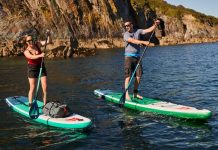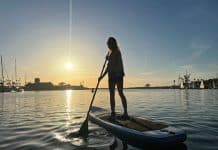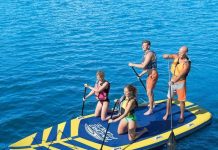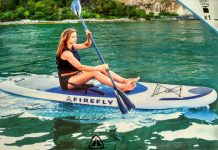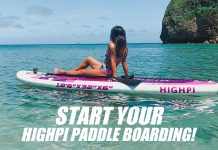Looking for a fun and exciting way to stay fit while enjoying the great outdoors? Look no further than paddleboarding! Whether you’re a seasoned athlete or a beginner looking to try something new, paddleboarding offers a unique experience that combines exercise and adventure. With its origins in Hawaii, this water sport has gained popularity all over the world. Grab a paddleboard and join us as we explore how paddleboarding can help you achieve your fitness goals while having a blast on the water.
Paddleboarding Basics
Paddleboarding, also known as stand-up paddleboarding (SUP), is a water sport that involves standing on a paddleboard and using a paddle to move across the water. It combines elements of surfing and kayaking, providing a unique and enjoyable experience for people of all ages and fitness levels.
What is paddleboarding?
Paddleboarding is a versatile activity that can be enjoyed on various bodies of water, including lakes, rivers, and even the ocean. It offers a great way to explore scenic waterways while engaging in a full-body workout. Whether you are a beginner or an experienced paddler, paddleboarding offers a range of benefits and opportunities for fun and recreation.
Types of paddleboards
There are different types of paddleboards available, each designed to cater to specific needs and preferences. The most common types include all-around paddleboards, touring paddleboards, inflatable paddleboards, and surfing paddleboards. All-around paddleboards are suitable for beginners and can be used in a variety of conditions. Touring paddleboards are designed for longer distances and provide stability and speed. Inflatable paddleboards are portable and convenient, while surfing paddleboards are designed for riding waves.
Choosing the right paddleboard
When choosing a paddleboard, it’s important to consider factors such as your skill level, body weight, and the type of water you’ll be paddleboarding on. Beginners should opt for stable and wider boards to help with balance, while more experienced paddlers may prefer narrower boards for speed. It’s also essential to choose a paddleboard that is made from durable and high-quality materials to ensure its longevity.
Essential equipment for paddleboarding
In addition to a paddleboard, there are a few essential pieces of equipment that you’ll need for a safe and enjoyable paddleboarding experience. These include a paddle suited to your height, a leash to keep you connected to your board in case of falls, and a personal flotation device (PFD) for safety. Depending on the weather conditions, you may also need appropriate clothing, such as a wetsuit or rash guard, to keep you comfortable.
Understanding paddleboard anatomy
To fully grasp the art of paddleboarding, it’s important to familiarize yourself with the anatomy of a paddleboard. The main components of a paddleboard include the nose, tail, deck, rails, fins, leash attachment point, and deck pad. Understanding these components will not only help you choose the right paddleboard but also improve your overall performance and control on the water.
Benefits of Paddleboarding
Paddleboarding offers a wide range of physical, mental, and social benefits. Whether you’re looking to get fit, reduce stress, or have fun with friends and family, paddleboarding has something to offer everyone.
Full-body workout
Paddleboarding provides a fantastic full-body workout that engages your core, arms, back, and legs. Balancing on the board and propelling yourself through the water requires a combination of strength, stability, and endurance. Over time, regular paddleboarding can help improve your overall fitness levels and tone your muscles.
Improves balance and core strength
One of the key benefits of paddleboarding is its ability to improve balance and core strength. Balancing on the unstable surface of a paddleboard requires constant engagement of your core muscles. By regularly practicing paddleboarding, you can develop better balance, stability, and a strong core, which can benefit you in various other physical activities and daily life.
Reduces stress and promotes mental well-being
Spending time on the water and connecting with nature has been proven to have positive effects on mental well-being. Paddleboarding allows you to escape the stresses of everyday life and immerse yourself in the calming environment of the water. The rhythmic movement of paddling can also have a meditative effect, helping to reduce stress and promote a sense of calm and relaxation.
Low-impact exercise
Paddleboarding provides a low-impact workout that is gentle on the joints, making it suitable for people of all ages and fitness levels. Unlike high-impact activities like running or jumping, paddleboarding allows you to exercise without putting excessive strain on your joints, reducing the risk of injury and allowing for a longer, more sustainable fitness routine.
Social and recreational benefits
Paddleboarding is not only a great way to stay active but also offers social and recreational benefits. Whether you paddleboard with a group of friends, join a paddleboarding club, or participate in events and races, it provides an opportunity to connect with like-minded individuals and build a sense of community. Paddleboarding can be a fun and social activity that allows you to enjoy the water and spend quality time with friends and family.
Getting Started with Paddleboarding
Before you hit the water, there are a few essential steps to follow to ensure a safe and enjoyable paddleboarding session.
Finding a suitable location
First, you need to find a suitable location for paddleboarding. Look for calm and relatively flat water with minimal boat traffic, especially if you’re a beginner. Lakes, calm rivers, and sheltered coastal areas are often good options. Make sure to check local regulations and obtain any required permits before paddleboarding in a specific area.
Preparing for your paddleboarding session
Once you’ve chosen a location, it’s important to prepare yourself and your equipment. Dress appropriately for the weather conditions, including sunscreen, a hat, and sunglasses to protect yourself from the sun. Make sure your paddleboard is properly inflated and secure all necessary equipment, such as the leash and personal flotation device. It’s also a good idea to bring water and a snack to stay hydrated during your session.
Learning basic paddleboarding techniques
Before you get on the water, it’s essential to learn and practice basic paddleboarding techniques. This includes proper paddling technique, standing up and balancing on the board, and turning and maneuvering. Familiarize yourself with the correct body posture, grip, and paddling strokes to maximize efficiency and reduce the risk of injury. It can be helpful to take a beginner’s paddleboarding lesson or watch online tutorials before you start.
Staying safe on the water
Safety should always be a top priority when paddleboarding. Always wear a leash to keep yourself connected to the board and prevent it from drifting away in case of falls. Additionally, wearing a personal flotation device (PFD) is essential, especially in areas where it is required by law. Before heading out, check the weather conditions and water temperature to ensure they are suitable for paddleboarding. Be aware of your surroundings and other water users, such as boats and swimmers, to avoid any accidents.
Proper warm-up exercises
Before getting on your paddleboard, it’s important to warm up your body to prevent injuries, especially if you’re planning a vigorous paddleboarding session. Perform a series of dynamic stretches and exercises that target the muscles you’ll be using during your paddleboarding session. This can include arm circles, lunges, squats, and light cardio exercises. A proper warm-up will prepare your body and mind for the physical activity ahead.
Paddleboarding for Fitness
Paddleboarding is not just a recreational activity; it can also be an excellent way to improve your fitness levels and achieve your fitness goals.
Cardiovascular benefits
Paddleboarding provides an effective cardiovascular workout that can help improve your heart health and stamina. By paddling at a moderate intensity, you can elevate your heart rate and increase your aerobic capacity. Whether you choose to paddle at a steady pace or incorporate interval training, paddleboarding can help improve your cardiovascular fitness, making activities like hiking, biking, and running easier.
Building strength and endurance
Paddleboarding requires upper body and core strength to propel yourself through the water. As you paddle, your arms, shoulders, and back muscles are engaged, building strength and endurance over time. The continuous effort of balancing on the board also activates your core muscles, helping to develop a strong and stable core. Regular paddleboarding sessions can lead to improved strength and endurance, benefiting you in everyday activities and other forms of exercise.
Improving flexibility and joint health
The movements involved in paddleboarding require flexibility in the arms, shoulders, and hips. As you paddle and twist your upper body, these movements help improve joint flexibility and reduce stiffness. Regular paddleboarding can also promote better range of motion in your joints, enhancing overall mobility and reducing the risk of injuries.
Burn calories and promote weight loss
Paddleboarding is an excellent calorie-burning activity that can aid in weight loss and weight management. The combination of paddling and balancing on the board requires a significant amount of energy expenditure. Depending on your body weight and intensity of the session, paddleboarding can burn up to 500 calories per hour. Incorporating paddleboarding into your regular fitness routine can contribute to a healthy and sustainable weight loss journey.
Incorporating paddleboarding into a fitness routine
To make the most of paddleboarding for fitness, incorporate it into a well-rounded fitness routine. Combine paddleboarding with other activities such as strength training, flexibility exercises, and cardio workouts to achieve a balanced fitness regimen. Consider paddleboarding on alternate days to allow your body to recover and vary the intensity and duration of your sessions to prevent plateaus. Additionally, consider joining paddleboarding classes or participating in fitness events and challenges to stay motivated and track your progress.
Paddleboarding for Fun
While paddleboarding offers numerous fitness benefits, it is also an incredibly fun and enjoyable activity that allows you to explore, connect with nature, and engage in recreational water sports.
Exploring scenic waterways and coastlines
One of the most enjoyable aspects of paddleboarding is the ability to explore beautiful waterways and coastlines. Whether it’s a peaceful lake surrounded by lush vegetation or an awe-inspiring coastal area with majestic cliffs, paddleboarding allows you to immerse yourself in the natural beauty around you. Take your time to navigate through winding rivers, glide across crystal-clear waters, and discover hidden coves and beaches to truly appreciate the wonders of nature.
Engaging in water sports and games
Paddleboarding opens up a world of possibilities for engaging in various water sports and games. From paddleboard yoga and fitness classes to SUP polo and paddleboard fishing, there are endless activities to try on your paddleboard. Challenge yourself and your friends to races, relay games, or even invent your own paddleboarding games. The versatility of paddleboarding makes it a perfect platform for group activities and friendly competition.
Joining paddleboarding groups and clubs
Paddleboarding offers a great opportunity to connect with like-minded individuals and join paddleboarding groups and clubs. These communities often organize group paddles, social events, and workshops, providing a supportive and engaging environment to improve your skills and meet new friends. Being part of a paddleboarding community can enhance your overall experience and make paddleboarding even more enjoyable.
Participating in paddleboarding events and races
For those who enjoy a more competitive edge, paddleboarding events and races provide an exciting opportunity to test your skills and compete against others. From endurance challenges that involve paddling long distances to SUP surfing competitions and river races, there are events for every skill level and interest. Participating in paddleboarding events can push you to become a better paddler and give you a sense of accomplishment and camaraderie.
Paddleboarding with friends and family
Paddleboarding is a fantastic activity to enjoy with friends and family. Whether you’re paddling side by side, organizing a group paddle, or just having fun with water games, paddleboarding can create lasting memories and strengthen bonds. It’s a great way to spend quality time together while enjoying the beauty of nature and staying active. Paddleboarding is suitable for people of all ages, so you can involve everyone and make it a fun and inclusive activity.
Paddleboarding Techniques
To make the most of your paddleboarding experience and improve your skills, it’s important to learn and practice various paddleboarding techniques.
Paddling techniques for different conditions
Different water conditions require different paddling techniques. When paddling on calm water, you’ll want to use longer and slower strokes to maintain stability and efficiency. In choppy or windy conditions, shorter and more powerful strokes can help you navigate through the water. It’s essential to learn and practice different paddling techniques to adapt to various conditions and maximize your performance on the water.
Standing and balancing on a paddleboard
Maintaining proper balance and posture on the board is key to a successful paddleboarding session. When transitioning from kneeling to standing, start by placing your hands on the board and slowly pushing yourself up. Keep your feet shoulder-width apart for stability and slightly bend your knees to absorb any movements. Engage your core muscles to maintain balance and focus on fixing your gaze ahead to help stabilize your body.
Turning and maneuvering on a paddleboard
To turn your paddleboard, you can use a combination of paddle strokes, body movements, and weight shifts. To turn to the right, place your paddle in the water on the left side of the board and take a sweeping stroke away from the board. At the same time, shift your weight to your left foot and lean your body towards the direction you want to turn. Practice different turning techniques to improve your maneuverability and control on the water.
Recovering from falls and getting back on the board
Falling off the paddleboard is part of the learning process, especially for beginners. When falling, try to fall away from the board to avoid landing on it and causing injuries. If you’re unable to prevent falling onto the board, try to protect yourself by bending your knees and tucking your body. Once in the water, retrieve your board, position it in front of you, and use a combination of kicking and pulling yourself up to get back on the board. Practice falling and getting back on the board in a controlled environment to build confidence and improve your recovery skills.
Advanced paddleboarding techniques
Once you’ve mastered the basics of paddleboarding, you can challenge yourself with advanced techniques and maneuvers. These can include pivot turns, cross bow turns, and riding waves. Advanced paddleboarding techniques require a combination of paddle skills, body control, and precise timing. It’s important to gradually progress and practice in safe conditions to avoid accidents and injuries. Taking advanced paddleboarding lessons or learning from experienced paddlers can help you refine your skills and expand your paddleboarding repertoire.
Paddleboarding Gear and Accessories
Having the right gear and accessories is essential for a safe and enjoyable paddleboarding experience.
Choosing the right paddle
Selecting the correct paddle is crucial for efficient and comfortable paddling. Consider factors such as your height, paddling style, and the type of paddleboarding you’ll be doing. Paddles come in various materials, lengths, and blade shapes. Adjustable paddles are a popular choice as they allow for customization and easy sharing among different people. Consult with a paddleboarding professional or experienced paddler to help you choose the right paddle for your needs.
Selecting the appropriate clothing and footwear
When paddleboarding, it’s important to dress appropriately for the weather conditions and water temperature. If the water is cold, opt for a wetsuit or drysuit to keep you warm and comfortable. In warmer conditions, wear lightweight and moisture-wicking clothing to help regulate your body temperature. Avoid cotton as it retains moisture and can make you feel cold. Additionally, choose footwear that provides good grip and protects your feet from sharp objects or slippery surfaces.
Sun protection essentials
Protecting yourself from the sun’s harmful rays is essential when paddleboarding, especially during long hours on the water. Wear a wide-brimmed hat and sunglasses to shield your face and eyes from direct sunlight. Apply a sunblock with at least SPF 30 to exposed areas of your skin, even on cloudy or overcast days. Don’t forget to reapply regularly, especially if you’re in and out of the water. These sun protection essentials will help prevent sunburn and long-term damage caused by UV rays.
Safety gear and flotation devices
Safety should always be a priority when paddleboarding. Wearing a personal flotation device (PFD) is crucial, especially for beginners and in areas where it is required by law. A PFD ensures your safety in case of falls or accidents. Additionally, consider using a whistle or signaling device to attract attention in emergency situations. It’s important to have a safety leash attached to your paddleboard to prevent it from being carried away if you fall off. These safety gear and flotation devices can make a significant difference in your overall safety and well-being on the water.
Optional accessories for convenience and performance
There are various optional accessories available that can enhance your paddleboarding experience. These include waterproof cases or bags for storing your belongings, paddleboard racks for transporting your board, and paddleboard tethers for securing your paddle while you’re not using it. Other accessories such as GPS devices, waterproof cameras, and fitness trackers can add value to your paddleboarding sessions. Consider your specific needs and preferences when choosing optional accessories to optimize your comfort, convenience, and performance on the water.
Paddleboarding Safety Tips
Adhering to safety guidelines and taking necessary precautions is essential for a safe and enjoyable paddleboarding experience.
Checking the weather and water conditions
Before heading out for a paddleboarding session, check the weather forecast and water conditions. High winds, rough waves, and storms can make paddleboarding unsafe and increase the risk of accidents. Avoid paddling in extreme weather conditions or on bodies of water with strong currents or dangerous tides. It’s essential to be aware of any potential hazards and plan your paddleboarding session accordingly.
Using a leash and wearing a personal flotation device
Always wear a leash when paddleboarding. A leash keeps you connected to your board and prevents it from being carried away by waves or currents. In the event of a fall, a leash ensures that you can quickly retrieve your board and stay close to it for safety. Additionally, wearing a personal flotation device (PFD) is crucial, especially for those who are not strong swimmers or when paddleboarding in unfamiliar waters. A PFD provides buoyancy and can be life-saving in emergency situations.
Developing good situational awareness
Maintaining good situational awareness is key to staying safe on the water. Be aware of your surroundings, including other boaters, swimmers, and potential obstacles. Pay attention to your proximity to shores, docks, and other structures. It’s important to avoid crowded areas and give way to larger vessels. Developing good situational awareness will help you make informed decisions and react quickly to ensure your safety and the safety of others.
Learning how to fall safely
Falling off the paddleboard is a normal part of the learning process, especially for beginners. Knowing how to fall safely can prevent injuries and minimize the risk of accidents. When falling, try to fall away from the board to avoid landing on it. If you’re unable to avoid falling onto the board, try to protect yourself by bending your knees and tucking your body. Practice falling and getting back on the board in a controlled environment to build confidence and improve your recovery skills.
Emergency procedures and knowing basic first aid
Being prepared for emergencies is crucial when paddleboarding. Familiarize yourself with basic first aid procedures and carry a basic first aid kit with you. Learn how to recognize signs of exhaustion, hypothermia, and other common water-related risks. If you’re planning to paddle in remote areas, it’s a good idea to have a communication device, such as a mobile phone or marine radio, to call for help if needed. Being prepared for emergencies can make a significant difference in the outcome of potentially dangerous situations.
Paddleboarding Destinations
Paddleboarding opens up a world of possibilities for exploring and enjoying various waterways around the world.
Top paddleboarding spots around the world
From clear tropical waters to secluded mountain lakes, there are countless top paddleboarding spots around the world that offer breathtaking scenery and fantastic paddleboarding experiences. Some popular destinations include Lake Tahoe in the United States, Lake Louise in Canada, the Maldives, the Amalfi Coast in Italy, and the Whitsunday Islands in Australia. These destinations provide beautiful surroundings and diverse water conditions suitable for all kinds of paddleboarding adventures.
Beautiful lakes and rivers for paddleboarding
Lakes and rivers offer tranquil settings with smooth water surfaces, making them perfect for leisurely paddleboarding sessions. Some beautiful lakes and rivers for paddleboarding include Lake Michigan in the United States, Lake Lucerne in Switzerland, the Danube River in Europe, and the Amazon River in South America. Paddleboarding on these serene bodies of water allows for a peaceful and immersive experience surrounded by stunning landscapes.
Coastal areas and ocean destinations
For those seeking adventure and excitement, paddleboarding along the coastlines and in the ocean provides a unique and thrilling experience. Coastal areas and ocean destinations, such as the Hawaiian Islands, Bali in Indonesia, the French Riviera, and the Great Barrier Reef in Australia, offer opportunities for riding waves, exploring sea caves, and encountering marine life. Paddleboarding in coastal and ocean environments requires more advanced skills and knowledge of surf conditions and safety precautions.
Family-friendly paddleboarding locations
Paddleboarding can be enjoyed by people of all ages, making it a great activity for families. Many destinations offer family-friendly paddleboarding locations with calm waters and gentle conditions. Some examples include Lake Pichola in India, Lake Bled in Slovenia, the Florida Keys in the United States, and the Algarve region in Portugal. These locations provide a safe and enjoyable environment for families to paddle together and create lasting memories.
Paddleboarding tours and travel tips
If you’re unsure of where to go or want to make the most out of your paddleboarding trip, consider joining a paddleboarding tour or seeking advice from experienced paddleboarders or tour operators. Paddleboarding tours can provide expert guidance, equipment rentals, and organized itineraries, allowing you to explore the best spots and make the most of your paddleboarding adventure. Before embarking on a paddleboarding trip, research local regulations, travel advisories, and any necessary permits to ensure a smooth and enjoyable experience.
Paddleboarding Challenges and Competitions
For those seeking a more competitive and challenging paddleboarding experience, there are various events and competitions that cater to different skill levels and interests.
Endurance challenges like long-distance paddling
Endurance challenges involve paddling long distances and testing your stamina and mental toughness. These challenges can range from paddling across long lakes or rivers to multi-day expeditions in various terrains. Participating in endurance challenges can push you to your limits and provide a great sense of achievement. It’s important to train and prepare adequately for these challenges, including building up your endurance, planning routes, and ensuring you have the necessary equipment and support.
SUP surfing competitions
SUP surfing competitions focus on riding waves on a paddleboard. These competitions can be held in ocean surf spots where participants are judged on their style, creativity, and performance on the waves. SUP surfing requires a combination of paddle skills, physical fitness, and wave-reading abilities. If you’re interested in SUP surfing competitions, it’s important to practice in appropriate surf conditions, develop your wave-riding skills, and learn proper surf etiquette.
River and whitewater paddleboarding challenges
River and whitewater paddleboarding challenges are for more advanced paddlers who enjoy navigating fast-moving water and rapids. These challenges require specialized equipment and advanced knowledge of river paddling techniques. Participating in river and whitewater paddleboarding challenges can be thrilling and rewarding but also carries higher risks. It’s essential to have proper training, experience, and safety gear to ensure your safety in these challenging water environments.
Exploring paddleboarding races
Paddleboarding races offer an opportunity to test your speed and compete against other paddlers. Races can range from short sprints to long-distance events and can take place in various water conditions, including calm lakes and open ocean. Participating in paddleboarding races can be a great way to challenge yourself, set goals, and measure your progress. It’s important to train and prepare for races, including improving your paddling technique, building your endurance, and familiarizing yourself with race rules and regulations.
Competitive SUP yoga and fitness events
SUP yoga and fitness events combine paddleboarding with yoga and fitness activities, creating a unique and challenging experience. These events often involve practicing yoga poses or fitness exercises on the paddleboard, adding an element of balance and stability. Participating in SUP yoga and fitness events can enhance your paddleboarding skills, improve your balance and flexibility, and provide a fun and social atmosphere. Prior experience in yoga or fitness training is recommended before participating in these events.
Paddleboarding offers a range of activities and possibilities for people of all ages and interests. Whether you’re looking for a full-body workout, a way to relax and enjoy nature, or an adrenaline-pumping adventure, paddleboarding has something to offer everyone. By understanding the basics of paddleboarding, choosing the right equipment, and practicing proper techniques, you can embark on an enjoyable and rewarding paddleboarding journey. So grab your board, paddle your way to fitness and fun, and explore the endless possibilities of paddleboarding!


